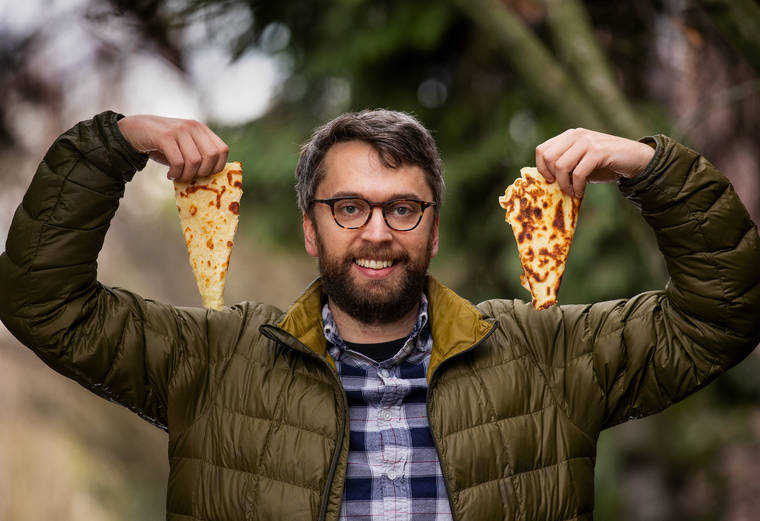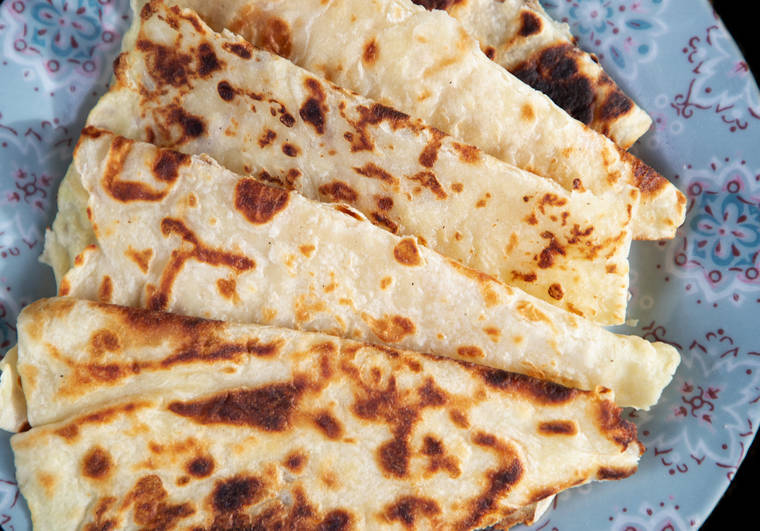Gather your household for an age-old Norwegian tradition this holiday season: Making lefse

Charles Schrag has been making Norwegian lefse, a potato-based flatbread typically reserved for the holidays, since he was young. On Dec. 7, 2020, Schrag shows off some of his lefse near his Seattle-area home. (Mike Siegel/The Seattle Times/TNS)

Charles Schrag of Seattle has been making the traditional Norwegian food lefse since he was young. Schrag shows off his lefse, which is similar to a flatbread, made with potatoes near his Seattle-area home, Dec. 7, 2020. (Mike Siegel/The Seattle Times/TNS)
Lefse. It’s a paper-thin flatbread, made from potatoes and cooked on a griddle, flipped with a long, narrow wooden stick, and eaten slathered with butter, sugar and sometimes cinnamon. If you’re of Norwegian heritage, you’ve most likely eaten it at Thanksgiving or Christmas for as long as you can remember.
Lefse. It’s a paper-thin flatbread, made from potatoes and cooked on a griddle, flipped with a long, narrow wooden stick, and eaten slathered with butter, sugar and sometimes cinnamon. If you’re of Norwegian heritage, you’ve most likely eaten it at Thanksgiving or Christmas for as long as you can remember.
Growing up, when celebrating Christmas with my dad’s side of the family, lefse (pronounced “lef-suh”) was an outlier on the table, sitting on a cut crystal platter among bowls of meatballs, cavatelli, cheese-filled ravioli and platters of braciola. It was the one thing my Grandma Jean (the lone Norwegian amid her Italian husband and their seven children) had from her side of the family.
It was never the star of the show, and to be fair, how could a bland potato pancake shine when set up against ravioli and braciola? Still, I always looked forward to lefse, and as an adult I asked my grandma to teach me how to turn what is essentially cold mashed potatoes into a tissue-thin vessel for copious amounts of salty butter.
The recipe itself is simple: riced potatoes mixed when hot with cream and butter, chilled and mixed with flour. However, to create the mottled sheets, you need a griddle, a lot of flour or a pastry cloth — a corrugated rolling pin is optional, but any rolling pin must be covered with a pastry sock — and that long, flat lefse stick to transfer the raw lefse to the hot griddle and to flip them while cooking.
It took me a long time and many attempts to achieve my Grandma Jean’s level of thinness, as making lefse truly is a labor of love. After she died in the winter of 2019, I found myself in possession of her original Bethany Heritage Grill, her corrugated rolling pin, her pastry sock, and the realization that I could never again call her for a lesson or a conversation on how she first came to making lefse. Only then did I fully understand that, like many family recipes, lefse is so much more than potatoes.
Daytona Strong, author of the cookbook “Modern Scandinavian Baking” and the host of the forthcoming podcast Kitchen Counter Conversations, says lefse ranks “near the top of all Scandinavian foods because of the associations and memories I have with it.”
“To me it represents one of the ways my family showed love and hospitality to everyone who received a package of lefse that had been prepared with love,” Strong says.
While there are many kinds of flatbread popular in Norway, there are two main types of lefse made in the U.S.: hardanger lefse, which is a hard, crackerlike lefse that must be softened with water before eating, and the soft potato lefse. The potato is more common than the hardanger variety in much of the United States.
Seattle resident Charles Schrag has been making potato lefse since he was a kid, and for him, lefse is about tradition.
“Honestly, it’s like a five out of 10 for me on taste,” he says, with a laugh.
Schrag grew up in Freeman, South Dakota, a small, predominantly Mennonite community in the southeastern part of the state. Lefse came to be part of his family’s holiday traditions by way of his Danish maternal grandmother who lived in northern Minnesota.
“My mom’s side of the family would always get together for Thanksgiving and we would set up in the kitchen, mixing the dough the night before and then make an assembly line the next morning to make a huge pile of lefse,” Schrag says.
His grandma Katie Baird’s recipe calls for a box of potato flakes (a well-known shortcut that is said to provide consistent, good results) and evaporated milk.
“My grandmother’s cryptic instructions were that you had to cool it outside [overnight], not in the fridge. I think it was a way to save fridge space, but it was tradition,” Schrag says.
Making lefse together is a “good way to welcome new family members,” Schrag says. “It’s just an accessible recipe and they feel empowered and welcome really quick.”
Schrag has made lefse in South Dakota; Washington; Kansas; Manitoba, Canada; and Germany throughout his life, introducing it to friends all over the world, to varying degrees of excitement.
“It’s not always popular,” he says.
Seattle-born Susan Hale, a second-generation Norwegian American (who is currently “hiding out from COVID-19 on Molokai”), loves lefse.
“I love the taste. I’m a potato fan, and you’re eating potatoes with your hands! And what’s wrong with that?” Hale says. After our phone interview, Hale sent me a picture of the last time she ate lefse. It was a few months ago, the lefse purchased from Larsen’s Bakery of Crown Hill and displayed on a beautifully ornate plate — “a little plate that my grandfather used when he had a little snack, it is from Norway and has a cup and saucer to match,” Hale wrote.
For Hale, eating lefse brings back memories of “an innocent time when you were a kid at your grandparents’ house doing whatever you wanted to do.”
“There are smells and flavors that take you back,” Hale says.
And for Hale, lefse was always part of Christmas and any gathering with family — topped with butter.
“If we were really good, we got it with sugar. It was never a savory thing, always served with coffee from my grandparents in the afternoon,” Hale says.
Hale says there is a family recipe, but they bought lefse as frequently as they made it at home. And while Hale has only made it herself once (without good results), she just might try it this Christmas, using a recipe from Julia Child.
“I might try it and it might be a little different,” she says.
Strong, the cookbook author, first learned to make lefse with her Grandma Adeline, a woman born and raised in North Dakota who ended up working in a lefse factory in Seattle after moving to the area.
Strong’s paternal grandmother died in 2008 before she had a chance to “ask her to start telling me her stories.” Afterward, Strong made a concerted effort to make a lasting connection through baking with Grandma Adeline.
“She was my only grandma left, and if I had to go through that regret-laced pain again, I couldn’t bear it. She and I had been really close growing up and I have photos of baking lefse specifically when I was a tiny child,” Strong says.
Strong is an expert when it comes to Scandinavian baking recipes and says there are “probably as many recipes [for lefse] out there as there are families.”
“I am not so hung up on whether it’s the most authentic to use potato flakes or mashed, it’s what evokes the feeling in a family and what it is in a family, and how it helps a person share their heritage and their heart with the recipient. When it comes to Scandinavian baking, it’s all about the feeling,” Strong says.
I haven’t made lefse yet this year. My Grandma Jean’s griddle and all the accoutrements are at my parents’ house in North Dakota. But I might improvise and take a tip from Schrag, who simply uses a cast-iron pan with low sides and a spatula to turn his lefse. A pastry cloth and a sock for my rolling pin can be easily ordered online or picked up at the Ballard shop Scandinavian Specialties ($2.99 for a pack of two).
Lefse
Recipe from Jean Varriano
Yield: 25 lefse
Ingredients:
5 large russet potatoes
1/2 cup heavy cream
1 teaspoon salt
3 tablespoons unsalted butter
3-4 cups flour
1. In a large stock pot filled with enough water to cover, place peeled potatoes. Over medium-high heat, bring the water and potatoes to a gentle boil. Cook until potatoes are tender, 12-15 minutes from the start of the boil. Drain and place in a large mixing bowl.
2. Rice or mash potatoes thoroughly, making sure there are no lumps. Cut the butter into small chunks and mix with the potatoes, adding cream and salt. Keep mixing until thoroughly absorbed.
3. Cover and refrigerate for at least 8 hours or up to 2 days.
4. When ready to cook, heat an electric griddle to 450 degrees Fahrenheit, or use a cast-iron skillet or flat grill pan over medium-high heat. Prepare a workspace with either a pastry cloth or a well-floured surface.
5. In a smaller bowl, use a fork to mix 1 cup of riced potato mixture with 1/2 cup flour until it forms a smooth dough. Keep the larger bowl of potato mixture in the fridge, working with 1 cup at a time.
6. From the smaller bowl, take a golf ball-sized handful of dough and roll it between your hands to form a ball.
7. Flatten the dough with the heel of your hand to create a disc and place the dough on the floured surface or floured pastry cloth. Working from the center out, roll the dough into as thin of a circle as possible — or a thickness of 1/8 inch. Use additional flour to prevent sticking as necessary.
8. Using a lefse stick, bench scraper or spatula, lift the lefse and tap to release excess flour.
9. Lay in the skillet and cook 1 to 2 minutes on each side, until speckled with golden-brown spots.
10. Transfer to a clean tea towel, covering with another tea towel.
11. Continue rolling additional lefse while cooking. Keep cooked lefse under the tea towel to keep warm.
12. Store in the fridge for up to 1 week or freeze for up to 3 months.


